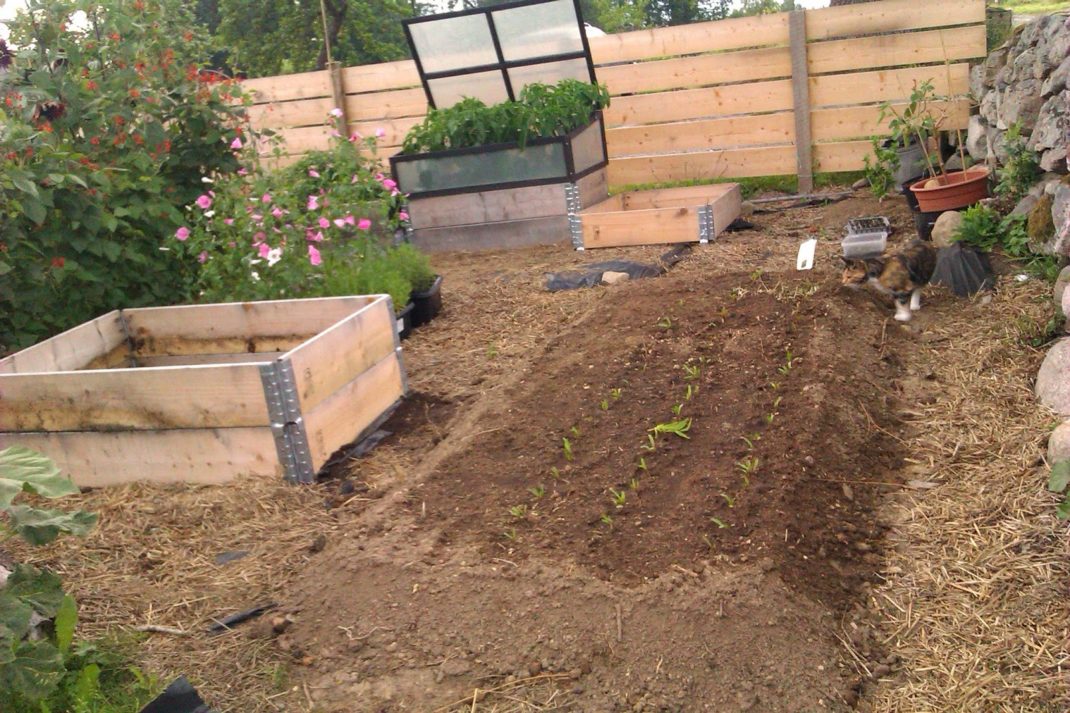How to create deep raised beds
The deep raised beds in my garden are amazing! I love growing vegetables in them since I know from the start that anything I sow or plant in them will produce such a good harvest.

A raised bed with deep soil, created in my garden 2012.
Deep raised beds are just that, raised beds of very deep soil. I can easily push a 2 feet (70 cm) long stick down into the soil without any significant effort. The beds will hold the moisture quite nicely during the season, especially if I cover the soil. They hold plenty of nutrients since I keep feeding them every season. It doesn’t hurt that they are placed in a sunny part of the garden, protected from winds. Ideal for anyone who wants to sow early in the season and get an early harvest.
It's fun to create deep raised beds. I created mine in fall when I felt like I had the time. Before I got started, I collected large piles of organic mulch next to where I planned the beds.
My beds are about 4 feet wide and from 10 to 30 feet long. Before I started digging, I marked the size of the beds using pegs with cords in between. Next, I used a spade to cut along the edges of the bed to simplify further digging. My form of double-digging starts at the short end of the bed where I first dig one row where the topsoil is removed two shovels deep and put in a wheelbarrow. I then fill the hole with organic biomass. When digging the next row, I put the dug-up soil on top of the newly added biomaterial in the first row. The procedure is then repeated until the whole area has been dug.
This way, I get a bed that is both raised and deeply dug, where the plant roots have plenty of opportunities to grow in the loose and mellow soil and with plenty of goodies for worms and insects.
Deep raised bed maintenance
The next spring, I used the bed for growing crops. At fall, after the harvest, I dug a ditch as deep as I could in the middle of the bed. I put as much organic material as possible into the ditch to feed the soil, then raked soil over on top to let the bugs do the mulching during the winter. The spring after, I dug a ditch at the short end of the bed and turned the next row over into it, much as when the bed was first created. This time without feeding the soil though.
This is how the maintenance of a deep raised bed is done, by re-digging it in spring and feeding it in the middle ditch at fall. So, using this method, no external soil is added to raise the bed. The extra soil comes from the organic biomaterial used to feed the bed.
Watch this video to see how I also mulch my pallet collars: Mulching raised beds
Organic materials that are suitable for direct mulching in a bed are any leftovers from the kitchen garden, leaves, cut-offs from perennials, horse manure, grass, compost, etc. Anything can become good soil, and quickly!
This spring I have been extra busy, so I have cheated and skipped the digging of the raised beds. This is a luxury I can indulge in after being so meticulous in earlier years. But I still feed the deep raised beds in fall with all sorts of organic matter to maintain the depth.
The beds are in the part of the kitchen garden set aside for root vegetables.
This picture is from late summer 2012 when the deep soil bed along the stone wall was just finished.
/Sara Bäckmo



Leave a Reply
You must be logged in to post a comment.